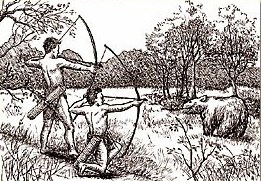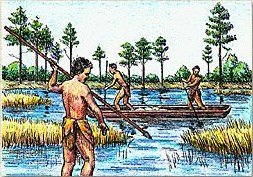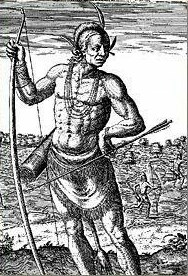|
Fishing and hunting were important activities for the Native Americans found living here by Sir Walter Ralegh's explorers and colonists in the 1580s, for Indians relied heavily on the meat of wild animals and fowl, and on fish, for their food.

Vicki Wallace Lacking conventional tools, or metal, they used the materials available to them and employed a high degree of ingenuity in devising methods for catching or killing fish and game. The Europeans were impressed especially, with their fishing techniques, which proved much more effective in the shallow sounds surrounding Roanoke Island than those employed by Ralegh's colonists. For the most part, the Indians caught their fish in net-like obstructions called weirs, which they placed across streams or channels in much the same way as modern pound-netters catch the seasonal runs of striped bass or shad. The weirs were made of reeds, woven or tied together, and anchored to the bottom by poles stuck into the sand. With their tops extending above the surface of the water the weirs looked very much like fences, and were arranged in varied patterns designed to catch the fish, and then impound them. One of the colonists, Thomas Harriot, described the Indian's weir-fishing technique as " settinge opp reedes or twigges int he water, which they soe plant one with another, that they growe still narrower, and narrower, " thus preventing the fish, once imprisoned, from swimming out again. 
Vicki Wallace The Englishmen reported that the Indians caught a wide variety of fish including " trout, porpoise, rayes, oldwives (probably menhaden), mullets, plaise (flounder), and very many other sorts of excellent good fish, which we have taken and eaten, whose names I know not but in the country language." They, also said that " for four months of the year, February, March, April and May, there are plenty of sturgeons. And also in the same months of herrings, some of the ordinary bigness of ours in England, but for the most part far greater, of eighteen, twenty inches, and some two feet in length. " 
From De Bry's America 1590 As was the case with most other American Indians, the natives of the Albemarle and Pamlico Sound regions relied to a great degree on bows and arrows for hunting. Harriot made special mention of black bears, which he said were " good meat, " adding that " the inhabitants in time of winter do use to take and eat many. They are taken commonly in this sort, " he said. " in some islands or places where they are, being hunted for as soon as they have spial of man, they presently run away, and then being chased, they climb and get up the next tree they can. From whence with arrows they are shot down stark dead, or with those wounds that they may after easily be killed. " Hunting the fleet-footed deer with bow and arrow was something else again, but the Indians often employed a special technique there as well, and one involving a high degree of skill and cunning. " These savages, " Harriot said, " being secretely hidden among high reeds, where oftentimes they find the deer asleep, and kill them. " Thus the Indians engaged in fishing and hunting not only to secure food, and hides for clothing and other uses, but as recreation and sport as well. Text by David Stick. Illustrations: Vicki Wallace |
Last updated: April 14, 2015
